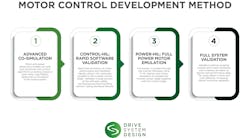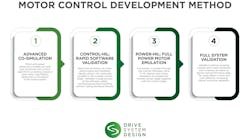Drive System Design Introduces New Method for Electric Motor Development
Drive System Design (DSD) — which specializes in the rapid engineering and development of electrified propulsion systems and associated technologies — has developed a new method to help speed up the design and development process for electric motors and inverters.
The company has developed a four-phase approach which aims to help customers save time and money during the design process. Per DSD, the four phases are:
- Phase 1 – Concept evaluation and design with advanced co-simulation. During this phase, control algorithms, finite element analysis (FEA) motor models and the power electronics model are designed and developed. A closed loop advanced co-simulation of the entire system will then be performed. By driving the system model with more representative control signals rather than simpler idealized inputs, early-stage identification of electromagnetic challenges along with accurate early-stage data for larger system analysis activities like noise, vibration and harshness (NVH), can be achieved.
- Phase 2 – Detailed design and validation with Control Hardware-in-the-Loop (C-HIL). DSD will utilize inverter control board hardware with deployed software and a real-time simulation of the motor model. The C-HIL hardware emulates motor behavior and sensor feedback such that a large proportion of the software and low voltage hardware validation can be performed. This phase allows for development and validation of safety monitoring and fault handling without risking hardware failures. Software development time is reduced for subsequent phases through bug fixing at this stage.
- Phase 3 – Component level testing with Power Hardware-in-the-Loop (P-HIL). At this stage, a large proportion of the inverter validation will take place by running full power through the inverter with deployed software and utilizing a battery and a high voltage motor emulator. The motor is modeled but real current and power is being pushed through real inverter hardware to validate its power stage and control. When a novel motor design is in the manufacturing stage, DSD can leverage its open platform inverter, to quickly and efficiently develop, calibrate and validate the motor controls for that application in this phase of testing.
- Phase 4 – System level testing and validation on a dyno test cell. The motor will enter the dyno test cell at this stage as a final system validation and characterization utilizing inverter and motor hardware as well as the battery emulator. Going through the previous stages ensures this phase will be as short, cost effective and efficient as possible.
According to DSD, most companies develop an electrification solution and take it directly to the dynamometer for testing, essentially going from Phase 1 straight to Phase 4. Doing so can cause a project to derail and months of extra development time to be added if critical issues occur during testing.
Using DSD's four-phase Motor Control Development Method instead though enables critical issues to be detected earlier in the process, saving time and money.
The company plans to employ this method when working with customers. With this new approach much of the inverter software and hardware can be developed and validated through Phase 2 and 3 while the motor hardware is being made said DSD in a press release announcing the launch of its Motor Control Development Method. This method can be applied to various vehicle types, benefiting many industries with their electrification efforts.
"There is immense benefit in minimizing project risk by following our four-phase approach. Too often, a push to be first-to-market ends up incurring more cost and time," said Jon Brentnall, president, Drive System Design, in the company's press release. "Ultimately, this approach will enable our customers to be first-time capable, meaning they will be set up for a successful pairing of the inverter and motor once the product reaches the dyno test cell. This will speed up final validation and significantly reduce the risk of needing extra hardware iterations, saving our customers both time and money while delivering a more high-quality product."
About the Author
Sara Jensen
Executive Editor, Power & Motion
Sara Jensen is executive editor of Power & Motion, directing expanded coverage into the modern fluid power space, as well as mechatronic and smart technologies. She has over 15 years of publishing experience. Prior to Power & Motion she spent 11 years with a trade publication for engineers of heavy-duty equipment, the last 3 of which were as the editor and brand lead. Over the course of her time in the B2B industry, Sara has gained an extensive knowledge of various heavy-duty equipment industries — including construction, agriculture, mining and on-road trucks —along with the systems and market trends which impact them such as fluid power and electronic motion control technologies.
You can follow Sara and Power & Motion via the following social media handles:
X (formerly Twitter): @TechnlgyEditor and @PowerMotionTech
LinkedIn: @SaraJensen and @Power&Motion
Facebook: @PowerMotionTech

Leaders relevant to this article:


